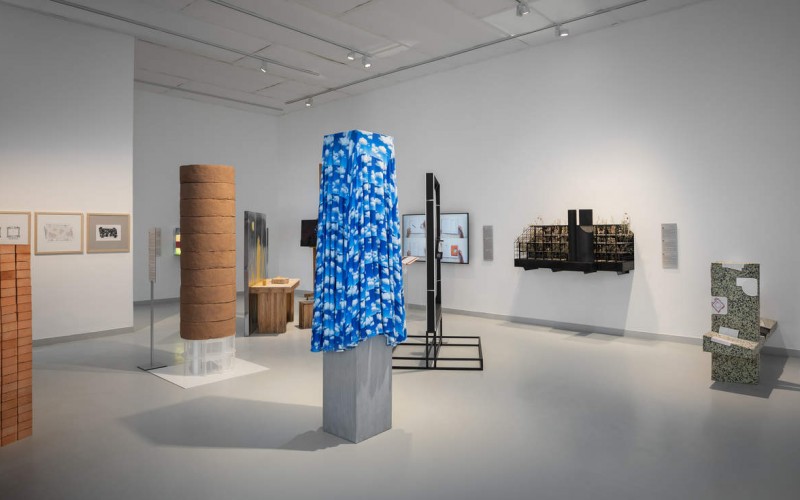The exhibition of the Hungarian Pavilion in Venice opened on the 22nd of May, organized again this year by the Ludwig Museum. Together with my fellow curators, the architects Attila Róbert Csóka, Szabolcs Molnár, and Dávid Smiló, the founders of Paradigma Ariadné, we received the commission to curate the exhibition in the summer of 2019. The basic idea was simple; we selected 12 Budapest buildings from the Late Modern period and asked 12 architecture offices and architects from nine countries in the region to provide alternative ideas for their future.
Naturally, we did not count on one factor, COVID-19 altering the context of our work. The Biennial was delayed for a full year, and the central motto “How Will We Live Together?” that seemed quite broad was given tangible content in the shadow of a global pandemic. In the middle of 2020, holed up and isolated in our own rooms, we had to ask the question of whether the concept that we had come up with and that had won us the job was still relevant in the present or whether we needed to modify it.
We decided in the end to further develop the original idea based on several factors. A part of this was naturally that the one-year delay hit us in the middle of our work, and a significant portion of the items to be displayed had already been produced. The commitment of the participating team as well as the decision by the organizer, the Ludwig Museum, convinced us to continue. In addition to this, we also were of the opinion that the chosen topic was current and important even if attention was focused elsewhere around the world. Besides our conviction on this matter, the awarding of the Pritzker Prize to the French architectural firm of Lacaton & Vassal provided a significant boost because the theoretical foundations for this company’s operations are quite close to the ideology that is the framework for the Othernity Project.
Thus, the work continued with the preparation of the objects and installations, the printing of the catalogue, the organization of related events and travel, the photography, and the agreements. Although we fundamentally directed the process from Budapest, we constantly tried to make it transparent for the participating foreign offices and architects, even though we only had a single chance to meet in person prior to the pandemic. Fortunately, we were able to retain the basic structure of the exhibition with an entrance in the rear section of the pavilion and two symmetrically placed halls that were mirror images of one another, a concept that had been fundamental to our submission, while also adhering to the strict regulations due to the pandemic.
The HMA MPDC Museum Department supported us in collecting the archival materials related to the 12 buildings. Through the aid of Pál Ritoók, we were able to use the files compiled for the Ybl Miklós Award nominations of Antal Lázár and Péter Reimholz as well as István Ferencz, and the valuable materials surviving in the bequests of Margit Pázmándi and István Szabó. The circumstances of the exhibition in Venice naturally do not make it possible to ship the original documents, so we photographed all of the archival materials collected on a single day at a studio provided to us by the Moholy-Nagy University of Art and Design. These 1:1 scale reproductions are displayed in the form of lightboxes at the site.
After a week of construction, the feedback from the media days on the 20th and 21st of May 2021 and from the opening to the public on the 22nd have been received positively by all of us. We have garnered a great deal of praise for the concept of the exhibition as well as for the two exhibit halls independently. Numerous visitors have pointed out the diversity of the materials displayed in the lightboxes, as well as how colorful and approachable the archival selections are. Following the one-year delay, which brought with it numerous problems, the positive comments from the Hungarian and international press are quite gratifying. We trust that over the next six months, the international audience will also show its appreciation, and this may lead to new thinking on the preservation of heritage from the Modern period even outside Hungary.
Dániel Kovács
For the virtual opening of the exhibition, please visit the YouTube channel of Ludwig Museum.
https://www.youtube.com/watch?v=J6gkfl-WNG4&ab_channel=LudwigM%C3%BAzeum
Othernity – Reconditioning Our Modern Heritage
Exhibition at the Hungarian Pavilion of the 17th International Architecture Exhibition – La Biennale di Venezia
22 May – 11 November 2021
National Commissioner: Julia Fabényi
Curator: Dániel Kovács
Curatorial team: Attila Róbert Csóka, Szabolcs Molnár, Dávid Smiló
Participants
A-A Collective (Poland / Denmark / Switzerland), Architecture Uncomfortable Workshop (Hungary), BUDCUD (Poland), b210 (Estonia), KONNTRA (Slovenia / North Macedonia / Croatia), LLRRLLRR (Estonia / United Kingdom), MADA (Serbia), MNPL WORKSHOP (Ukraine), Paradigma Ariadné (Hungary), PLURAL (Slovakia), Vojtěch Rada (Czechia), Studio Act (Romania)




